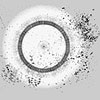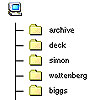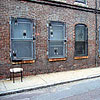 Originally
published
on
12/11/03
Originally
published
on
12/11/03Genomixer, a project by Stanza, presents a set of abstract interfaces based on the artist's DNA. Stanza worked with a medical lab to get his DNA profiled from a sample of his blood; the DNA was then formatted into a set of letters that he used to create raw texts and bitmaps from which the current project was created, presenting images and sound. The user can interact with each section of the web project to "alter the DNA."
The fact that Stanza developed a project based on his own DNA profile follows the art tradition of portraiture; however, the tradition is taken a bit further here because we have raw material (DNA) quickly becoming politicized through its re-contextualization as an online project. Ephemerality becomes a key point as the project encourages the user to create her own version of DNA. This information is then presented as beautiful abstractions that, unless one is aware of its contextualization, would simply be pretty material to look at. And so we are reminded of the dichotomy of the beautiful meaning something only when it is understood in a bigger context--opposed to it attaining meaning according to itself. The smokescreen between the beautiful and the political is then apparent, and makes the viewer consider how even the most formal of practices is dependent on a specific ideology -- one that would point to the source material--the form of presentation itself.
In Genomixer, however, we have formalism pointing back at the creative individual as its validating source. The only downside may be that the creative process appears systematic and a bit too abstract at times. Also, unexpectedly, a universalized reinforcement of the artist as "genius" can be read -- a proposition often frowned upon, but here, somehow, it actually slips in-between disapproval and reaffirmation of the cultural forces constantly haunting the artistic drive.
::Eduardo Navas::
 Originally
published
on
12/09/03
Originally
published
on
12/09/03The computerfinearts net collection will from now on permanently be hosted by The Rose Goldsen Archive of New Media Art, Division of Rare and Manuscript Collections, Cornell University Library, Ithaca New York. I pasted to whole agreement below so everyone can see the terms under which the net-art works went into The Rose Goldsen Archive of New Media Art:
---------------------------------
Rose Goldsen Archive of New Media Art
Division of Rare and Manuscript Collections Cornell University Library
The Rose Goldsen Archive of New Media Art, Division of Rare and Manuscript Collections, Cornell University Library, Ithaca New York, hereby agrees to serve as the permanent repository of the collection of internet art owned by computerfinearts under the supervision of Doron Golan.
computerfinearts will deposit in The Rose Goldsen Archive copies of internet artworks contained in its collection for the sake of preservation, evaluation, and exhibition in the Archive.
The Cornell Library will catalog, house, and preserve these materials, and make them available for viewing by Cornell students, faculty, staff, alumni, and other members of the public upon request. Materials will be cataloged in Cornell's online catalog and in other national bibliographic utilities under the name of the artist, as well as under the name of computerfinearts. The Rose Goldsen Archive agrees to accept directly from computerfinearts any updates of the works sent by the artists to computerfinearts.
computerfinearts and the individual artists, per their purchase or contribution agreement, will retain full copyright to these materials, including the right to disseminate, update, and/or publish other copies of these works in other forms and venues.
computerfinearts agrees to permit the Cornell Library to copy these materials for archival, educational, and exhibitional purposes internal to the Goldsen Archive or for the purposes of forwarding Cornell's teaching mission. No exhibition or dissemination of the materials outside the purposes described above shall take place without prior consultation and permission of computerfinearts and the exhibited artists.
If, as a result of unforeseen occurrences, were materials or data housed in the Goldsen Archive to be damaged, lost, and/or corrupted, computerfinearts agrees to absolve Cornell University Library of any liability.would hope for with such a style.
---------------------------------
::Peter Luining::
 Originally
published
on
12/08/03
Originally
published
on
12/08/03Public Alley 818 is a new series of location-based performances by Kanarinka of "Boston-based performance-multimedia-installation collective" Ikatun.
These events (to take place from December 2003 to February 2004) will be defined by net users in virtual places and performed in 'real' space, in and around public alley 818 in Boston, MA, USA between Symphony Road and Westland Avenue
Purposefully choosing a nondescript location that has just a number and no name, Kanarinka reminds us that the space from which we dictate the content and flux of the series of works are also describable as a number. Our virtual place has a coordinate not "used to determine the position of a point, line, curve, or plane in a space of a given dimension with respect to a system of lines or other fixed references" but, instead, to describe locality with regards to content and context while the 'real' performance space's location becomes almost irrelevant, abstracted, or virtual
"What is outside your door? How do you connect the whole entire world to one specific space?" The taking of mundane urban space and allowing a virtual place to dictate the events that will occur there transforms and shapes the space so that it is mythicized and distributed as a place that has an inescapable 'real' location yet only a virtual significance.
::Garrett Lynch::
editor's note: see call for participation posted on Thu Dec 04, 04:02:11 AM or visit: http://www.ikatun.com/k/publicalley818/